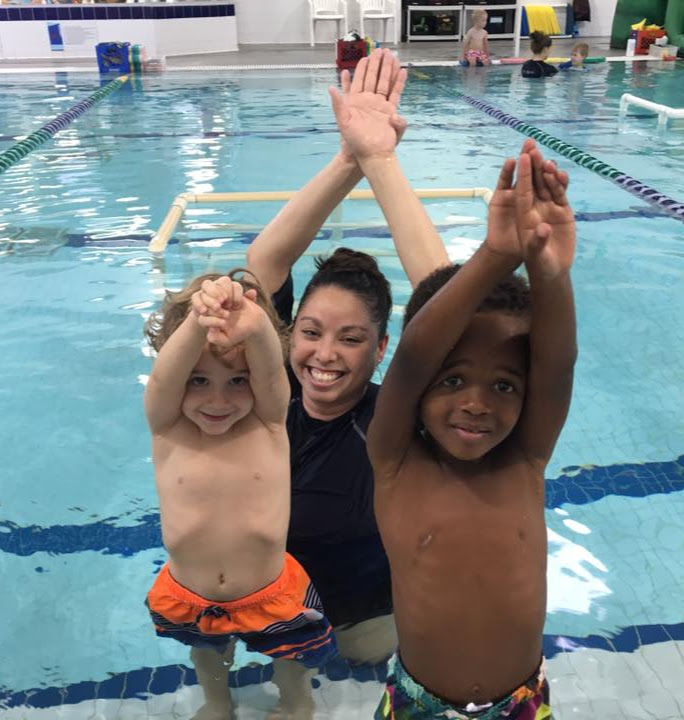
One of the most important takeaways about your children learning how to swim is that they enjoy it. Nothing puts a damper on pool-time or swim lessons like a rash, swimmer’s ear or cramps. Here at Hubbard Family Swim School, we have all the best swim protection tips to keep your little swimmers happy and healthy in and out of the pool. Here are a few quick remedies for common concerns in the pool:
Dry Skin/Hair:
Many swimmers experience the drying out of their skin and hair after being in the pool, leading to straw-like locks and cracked skin. This is a result of chlorine and other chemicals in the pool that help keep the water clean. These chemicals are a very good thing for keeping bacteria, viruses, and fungus from spreading… but not as good for hair and skin. The good news is, with a few quick tips, your kids can say goodbye to dry skin and hair!
Before going in the pool:
- Keep your kids moisturized all week, not just on days they have swim lessons. Going into the pool with skin that’s already healthy and moisturized can make a big difference coming out.
- Get your kids’ hair wet with clean water before pool time or swim class – believe it or not, hair is very absorbent. By rinsing their hair with clean water, the hair strand absorbs that water first, which means less of the chlorine will be absorbed when they get into the pool.
- Ocean lifeguard secret — put conditioner in your hair in the morning — don’t rinse it out – keeps the salt water and the chlorine from being absorbed
After swimming:
- Always shower after being in the pool, even if you only manage to give the kids a quick rinse-off. This will get these chemicals out of their hair and off their skin more quickly.
- Rehydrate! Make sure your kids stay hydrated with plenty of water after swim class and throughout the week. This promotes healthy, hydrated skin and hair and is also great for reducing swim cramps.
- The best remedies we’ve found for dry skin and hair are both pretty simple – argan oil and baby lotion. Baby lotion is a gentle way to rehydrate the skin and is super-safe. After class, a gentle coating of argan oil in the hair while it’s still damp is a great way to repair hair damage – but be stingy with the amount, less is more.
Dr. Seuss (Green) Hair?
- Green hair is very common for swimmers, especially those with lighter hair. Along with our other tips, swimmers shampoo can protect hair from chlorine and that green tint.
- Looking for a home remedy? Just pour 1/2 cup of tomato juice, white vinegar, or lemon juice on hair after swimming and comb through. These liquids are all very acidic and will remove the copper oxides in hair that causes it to turn green.
Swimmer’s Ear:
If you’ve ever spent a good amount of time at the pool, chances are you or your children have gotten water in your ears. Sometimes, the water will come out on its own, but other times it will stick around and cause what’s known as swimmer’s ear. This can cause balance problems, discomfort, and even pain.
- Call your doctor – serious infections don’t clear up without antibiotics… but the good news is that antibiotic ear drops will clear up swimmer’s ear in no time.
- Avoid water – more water will only make swimmer’s ear worse. It’s best to avoid the pool until it clears up. Remember, the sooner your fishy is better, the sooner they can get back to swimming!
- Over the counter pain meds like Advil, Motrin or Tylenol can all be a gentle over-the-counter quick fix for a painful case of swimmer’s ear.
- Ear drying drops can be used after swim class to quickly dry the ear canal and prevent water in the ear to progress to an infection. Remember, always read and follow the directions carefully, especially with young children.
- Persistent problems? Dry only your outer ear, wiping it slowly and gently with a soft towel or cloth. Tip your head to the side to help water drain from your ear canal. You can dry your ears with a blow dryer if you put it on the lowest setting and hold it at least a foot (about 0.3 meters) away from the ear. At-home preventive treatment.
- Remember – never put anything into your child’s ears. Sticking something like a Q-tip too far in can damage the eardrum or other important and fragile parts of the ear.
Red Eyes
Red eyes after getting out of the pool can be bothersome and is usually the result of opening eyes underwater or simply getting water in eyes after being in the pool all day. With a few quick remedies, red eyes can be cleared up easily.
- Wear goggles – if your child is prone to opening his or her eyes underwater, which most of our students are – goggles can help him or her see underwater without coming out looking like Dracula! Goggles come in all sorts of cool shapes and colors and can get your child even more excited about going to the pool.
- Do remember to have them swim occasionally for a few minutes without goggles -we don’t want them to panic if they fall in without their goggles
- Flush their eyes with cool, clean water or saline to get all the pool water out and provide instant relief. Simple over the counter eye drops made for swimmers can also help with red eyes as well.
- A cold compress over closed eyes can help soothe red eyes after a day at the pool.
Cramps
Cramps in the pool are absolutely no fun. Wherever they pop up, they can cause pain and can even scare your child. But with a little knowledge and preparations, a little cramp won’t stop your little one. Know what causes cramps: dehydration, fatigue, improper warm up, or overworking a certain muscle can all cause cramps. Knowing what causes them can help you pinpoint what the problem is – and how to avoid it or fix it.
- Warm up before pool time. A little stretching before getting in the pool can make the world of difference for cramps!
- Stay hydrated! Dehydration is one of the main causes of cramping during any physical activities. Drinking plenty of water is a quick fix for this.
- Eat your fruits and veggies. A proper diet will cut back on cramping and will also make sure your little fish has plenty of energy for swim lessons!
- Know your limits. Even a leisurely day at the pool can wear your children out and it’s important to take breaks to give their growing muscles a chance to rest and reset.
Rashes
Rashes from the pool can be caused by a number of things – chlorine, sunscreen , swimsuits, and even just pool water. The good news is, most rashes can be cleared up with ease.
- Back to an important swim protection rule: rinse after swimming! Getting pool water off your skin quickly can reduce irritation and prevent rashes.
- Always rinse your swimsuit and HAND wash it often (machine washing a swim suit usually wears it out really fast!). Not doing so can cause irritants as well as bacteria to build up on the suit, causing it to bother your child when they put it on. You may have to avoid some materials as well based on what bothers your child’s skin.
- Sometimes, chlorine in pool water or the water itself can cause skin irritation and rashes. These are usually short-lived and can be cleared up rather easily. If you have sensitive skin use a fragrance free lotion like vanicream before getting in. This seals the pores and keeps the chlorine out.
- Wear a rash guard – if the chemicals in the pool are the irritants, a rash guard can help by reducing the amount of contact your child’s skin has with the water. Toddler rash guards can also help protect your young ones from abrasion and irritants and sunburns!
If you remember these quick tips before, during, and after swimming, it’s easy to remedy common pool ailments and make swim protection a part of your routine. As long as you keep an eye out for swim safety and prevent or treat any problems that pop up quickly, swimming can be the most fun part of your kids’ week! If you have any questions or would like more information, please contact us today.



